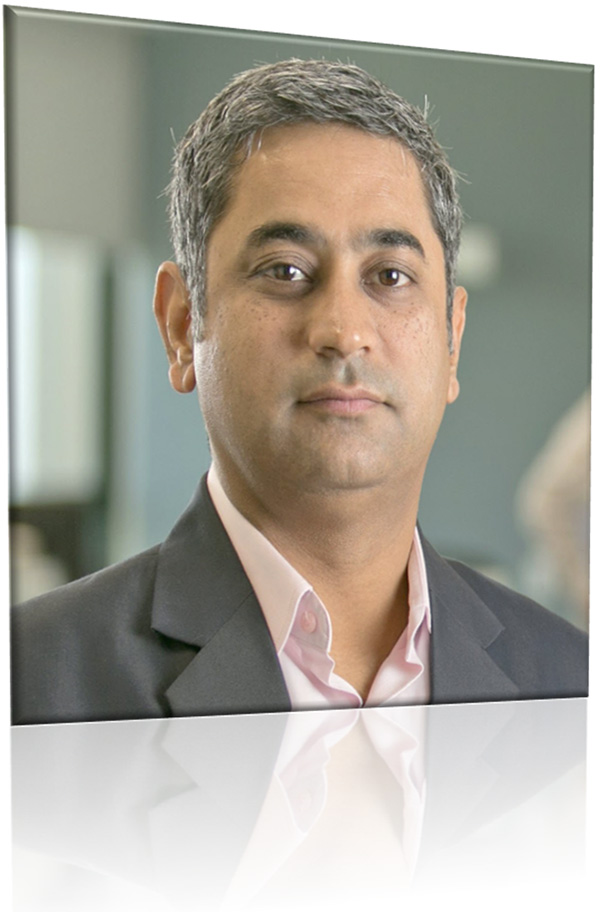Amit Dhingra, with more than 20 years of global experience in Telecommunications and Service Delivery, is the Senior Vice President – Nokia Operations & Global Service Delivery. He has a proven leadership track record of turning businesses around towards profitability, creating and implementing strategy as well as business development.
Amit joined Nokia in 2006 and has held progressive positions in the organization – Head of Services Strategy and Business Development; Head of Global Network Operations; Head of Delivery India region (where he was responsible for the service delivery and execution of services operations across the region); Vice President – Managed Services; and Vice President – Global Services Delivery. Over the years, he has been instrumental in contributing to the organization's growth and in defining the services growth strategy including the global delivery strategy. Prior to this, Amit was responsible for the strategic planning and development of the MS business services portfolio of Nokia worldwide.

Amit was instrumental in delivering the first Customer Experience Management (CEM) solution to large telecom operators in India and helped them to get the right network insight based on subscriber experience to provide detailed insight, reflecting on his unique ability to continuously innovate and adapt to changing business models, customer needs and technologies.
Amit’s new responsibilities as the Head of Nokia Operations include leading Nokia’s Supply Chain, Procurement, Shared Business Services and Quality with all the underlying processes, in order to ensure a seamless e2e customer experience. As part of the role Amit is also holding the Chief Procurement Officer role for Nokia.
Amit is an MBA in Finance and Strategy from the London Business School and holds a Bachelor’s degree in Electronics & Communication Engineering from the C.R. State College of Engineering, Haryana, India. In his spare time, Amit is enthusiastic about playing cricket and racquet sports as well as travelling and reading. Based in Gurgaon, India, Amit is married to Arti and has two school going children.
The Conversation
SSF: The world of telecom services is prime for a full adoption of automation, machine learning and predictive analytics applications for its services. With companies such as Nokia in the forefront, how are you adapting to the same in your organization?
Amit Dhingra: We realized the potential of AI and machine learning quite early, so more than four years ago we came up with Nokia AVA, which has also been rated as #1 telco and AI framework in the industry by many analyst houses. It has won over ten innovation awards in the industry. It enables predictive capabilities through data-driven insights and intelligence from network data. As an example, through machine learning and predictive analytics, we can predict and prevent service degradation of a cell site, up to seven days in advance. This means Communications Service Providers (CSPs) can predict issues before they occur to improve service quality and reduce customer complaints. Further, root-cause analysis and action recommendations give the operations teams further insight into how best to maximize network availability and boost service quality for subscribers. Likewise, we are also using analytics to solve challenges in supply chain management for smooth procurement and uninterrupted logistics management.
SSF: How can business services contribute better towards the corporate objectives and become partners to the business and not remain mere service providers?
Amit Dhingra: Nokia’s Global Service Delivery is a good example to explain this. Unlike conventional shared services centers, it is not an internal services shop.
Our global delivery centre is based on strong digitalization, automation, and artificial intelligence levers.
It collaborates with CSPs for co-creation of use-cases that bring business impact. While these levers are used for making Nokia’s internal operations faster, simplified, and optimized, the CSPs understand the value proposition brought across the entire network lifecycle of design, build, operate, and maintain.
This includes faster time to market telecom services, managing operational complexities, and reducing total cost of ownership. Through digital design, we also help these CSPs generate a better ROI and compensate for their legacy decline. Through process automation, we can help them generate up to 25% op-ex savings annually, optimize traffic throughput, and predict outages to save up to 5% TCO savings annually. Each of these steps cumulates to significant business impact.

SSF: How should digital transformation priority be set in an organization's context? What are your key transformation mantras for your organization?
Amit Dhingra: For any organization, digital transformation has become an absolute necessity for internal efficiency as well as for delivering value to customers. For setting this as a priority, an organization needs to clearly lay out a well-defined vision, have a right balance of skills and capabilities, have in place the right platform and data sets, and above all, build an insight-to-action mind-set, including an agile development approach. Our transformation mantra has been to follow an exhaustive strategy that we had defined to quickly adapt to changing times. We call it the RAPIDO strategy, which signifies focus on – Robotics & automation, Analytics & AI, People, Innovation, Digitalization and Operational efficiency. With these strategy elements, we now have an integrated service delivery to tackle challenges like fragmented tools and processes, multiple dashboards, and siloed data repositories.
SSF: Many organizations have fallen in the trap of doing POCs of RPA and going very slow after that. What has been your experience and how do you see a business services organization dealing with this as a strategy?
Amit Dhingra: While many industries have been using RPA for many years, we can proudly say Nokia was the first one to bring RPA to telecom domain. Not just limiting to POCs, we implemented the use-cases in live networks for monitoring, resolution, software upgrades, etc.
We achieved up to 50% faster handling of trouble-tickets, 20% faster logs collection, and other encouraging metrics. While the results are still good, we feel the challenges start when you need to scale up, or if there are frequent adaptations in the defined rules. We have traversed well beyond RPA and have started to digitize the methods-of-procedures. We already have a rich library of these digital assets (DigiMOPs), which we reuse across projects, network lifecycle stages, and geographies. With this new approach, we have improved the site build time by 50%.
SSF: Advanced tools such as AI, Blockchain, etc. are trending as the preferred platforms in services. Many organizations are still struggling to get the best of these. What has been your experience and what advice would you like to give to business services leaders in this context?
Amit Dhingra: At Nokia, we have taken a tremendous leap to move towards secure, automated, and data-driven service delivery in which we are continuously leveraging AI by injecting it where it matters the most. While we take our customers towards cognitive operations, we are injecting AI and, in the process, reducing op-ex, boosting quality and response times. In a 5G scenario, CSPs will spin up a network slice instantly under a dedicated Service Level Agreement (SLA) while AI will enable closed-loop automation from anomaly prediction to resolution. We have also explored the possibilities with Blockchain and have moved beyond Proof-of-Concept for new solutions. While we are still at the beginning of this journey, we are excited about the opportunities all these new platforms bring to make much more happen. So, the advice is to be bold, start early, start small, fail fast, quickly fix faults, and then scale up rapidly.
SSF: With the current situation likely to become the new normal, there is a huge dependency on technology, especially telecom networks. India has always leap frogged on technology/ telecom. How do you see the readiness of telecom infrastructure in India for this change, given the recent spike in load? What more needs to be done?
Amit Dhingra: The growth or readiness of telecom infrastructure in India can be gauged by our India Mobile Broadband Index 2020 report which showed that even before COVID-19 pandemic, the total data traffic in India increased by 44 times over the last four years.
Also, 4G constituted 96% of total data traffic consumed across the country and there is a demand for advanced solutions, as there is a growing requirement for more reliable, secure and higher-capacity connectivity.  Nokia’s Global Delivery Centre in India supports telecom operators in more than 65 countries, which also includes management of operations of networks across 36 countries. After the onset of the pandemic, our engineers have noticed a huge surge in network traffic across India and elsewhere. In the last few months, the traffic patterns in India have changed drastically. This includes data traffic generation from residential areas instead of corporate complexes, high data volume consumption throughout the day, etc. The networks were not necessarily designed and provisioned as per these patterns. So, through professional services and cognitive use-cases, these networks are being optimized and enhanced. The CSPs are also working with OTT (Over-the-top) players (like Netflix, Amazon Prime video and Hotstar) to enhance the quality of experience.
Nokia’s Global Delivery Centre in India supports telecom operators in more than 65 countries, which also includes management of operations of networks across 36 countries. After the onset of the pandemic, our engineers have noticed a huge surge in network traffic across India and elsewhere. In the last few months, the traffic patterns in India have changed drastically. This includes data traffic generation from residential areas instead of corporate complexes, high data volume consumption throughout the day, etc. The networks were not necessarily designed and provisioned as per these patterns. So, through professional services and cognitive use-cases, these networks are being optimized and enhanced. The CSPs are also working with OTT (Over-the-top) players (like Netflix, Amazon Prime video and Hotstar) to enhance the quality of experience.
SSF: With the WFH in much focus, two points which need to be taken care of could be data security/ cyber resilience and support from the government in enabling this. How do you see these panning out?
Amit Dhingra: The pandemic has forced everyone in the ecosystem to look at digital and virtual ways of doing things. However, cybersecurity threats are on the rise and getting more sophisticated. While the government is having a closer look at this aspect, the organizations will also have to relook their data security/ cyber resiliency strategies. This includes stringent adherence of corporate-level data security policies while working from home through a VPN (Virtual Private Network) connection or proper authentication.
During COVID-19 lockdown, our engineers were able to securely use tools and processes hosted in our private cloud.
As cybersecurity threat is a big issue for CSP networks, our Security Intelligence & Operations Centre, within the Global Delivery Centre, has been constantly analyzing the threat landscape to mitigate any malicious cyberattacks.
SSF: The market is quickly evolving from a centralized to a distributed cloud, and it is expected by 2020-21, 75% of enterprise-generated data will be processed outside of centralized data centers – how are you preparing for this now?
Amit Dhingra: We were able to foresee this few years back and we have been constantly preparing ourselves since 2017. We support the approach to have a distributed cloud comprising of centralized, aggregated edge and far-edge clouds for processing data, as close as possible to the end-users. Besides local legislations and data privacy requirements, this approach is crucial in the 5G and Industry 4.0 era, which involves a high volume of data transmission with low latency. Many of our offerings work in a hybrid cloud i.e. a combination of private and commercial public clouds. We believe it is the right strategy for meeting demands in a secure, cloud-native, and operable manner. Nokia has robust building blocks that are already implemented to provide a distributed cloud for our own as well as for our customers’ solutions. Few examples are – Nokia Digital Automation Cloud for private LTE, WING for a virtualized mobile network for IoT, Nokia Enterprise and Services Cloud for Infrastructure-as-a-service. All of these are end-to-end designed, deployed, and managed by Nokia, while data processing is done closest to our customers.
SSF: Plug-and-play and “as a service” (Infrastructure/ Platform/ Software) seems to be gaining traction rapidly. How do you see this new offering in terms of customer service, scalability, standardization, automation, and operational costs?
Amit Dhingra: In our analysis of 5G Maturity Index, we found that globally only 27% of CSPs provide services to more than one industry. Since the CSPs are looking to maximize their ROI so enterprise markets across industries will be their big focus. Keeping in mind the B2B2C and B2B2B models, we feel that CSPs are looking for agility, scalability, and flexibility to do so. For that reason, Nokia is offering new consumption-based business models for CSPs to enter new markets and generate revenue. As an example, through Platform-as-a-service, we enable CSPs to provide worldwide connectivity seamlessly to enterprises, using Worldwide IoT Network Grid (WING). Likewise, we are working on new models to help CSPs orchestrate the integration, fulfilment and revenue share of the 5G related use-cases – like ultra-low latency connectivity for autonomous vehicles in a port, mission-critical services for next-generation trains or provide high bandwidth immersive concert experiences.
SSF: What advice do you have for progressive business services, which are required to be agile/ disruptive on the one hand, and reliable/ balanced on the other? How can they enable business impact for the parent organization, beyond just productivity/ FTE saves?
Amit Dhingra: Business services must see beyond productivity lens and focus on value-addition for the business. As an example, our teams at Global Delivery Centre understand the business needs.  Hence beyond efficiency, the focus is on faster time-to-market the 4G/5G services, quality of services delivered, first-time-right percentage, complexity management, issue avoidance, etc. Value comes through a strong man-machine collaboration i.e. a virtual team of experts supported by robust digitalization, automation and Artificial Intelligence (AI) based tools and processes. All our services are standardized based on a common underlying digital network architecture and use a common data lake for pattern recognition and performance degradation prediction, so that issues are predicted, pre-emptive actions are taken, where possible or resolved quickly, if issues still occur.
Hence beyond efficiency, the focus is on faster time-to-market the 4G/5G services, quality of services delivered, first-time-right percentage, complexity management, issue avoidance, etc. Value comes through a strong man-machine collaboration i.e. a virtual team of experts supported by robust digitalization, automation and Artificial Intelligence (AI) based tools and processes. All our services are standardized based on a common underlying digital network architecture and use a common data lake for pattern recognition and performance degradation prediction, so that issues are predicted, pre-emptive actions are taken, where possible or resolved quickly, if issues still occur.
My advice for the progressive business services is to identify and then add the value needed as per business area, and focus on standardization, innovation, and digitalization. This is crucial as a lot of support is needed from tools, automation and digitalization of the processes, to manage any complex and sizable ‘operations’ beyond the direct customer delivery.
The Global Business Services in most organizations are handed over this crucial ask to maintain and run the business in a most effective and efficient manner. For me, the basic principles remain the same when it comes to processes around Order to Cash – ensuring happy customers, Source to Pay ensuring happy suppliers and Financial Services including Analysis, Reporting, Controlling and Statutory matters.
The most important ingredients for the success in these areas are:










